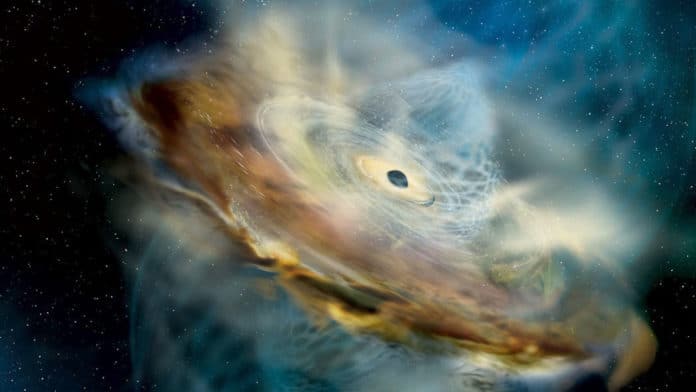In March 2018, astronomers observed a sudden change in brightness of a galaxy located 239 million light-years away. Known as 1ES 1927+654, the galaxy had brightened by 100 in visible light. Further observation by the NASA-funded Asteroid Terrestrial-impact Last Alert System revealed that the eruption started much earlier, at the end of 2017.
Reanalysis of the galaxy in May 2018 revealed elevated UV emission by 12 times. At that time, the brightness level was continually declining. Then, in June, the galaxy’s higher-energy X-ray emission disappeared.
The unusual disappearance of the X-ray emission provides astronomers with an important clue. They suspect the black hole’s magnetic field creates and sustains the corona so that any magnetic change could impact its X-ray properties.
José Acosta-Pulido, a co-author at the Canary Islands Institute of Astrophysics (IAC) on Tenerife, said, “It was fascinating to delve into this galaxy’s strange explosive episode and try to understand the possible physical processes at work.”
According to a recent study, an international science team has linked the eruption’s peculiar traits to changes in the black hole’s environment that such a magnetic switch would likely trigger. In other words, the rare and enigmatic outburst from the galaxy may have been sparked by a magnetic reversal.
A magnetic reversal is a spontaneous flip of the magnetic field surrounding its central black hole. These events frequently occur in space. The geologic record suggests that Earth’s magnetic field flips erratically, with a few reversals every million years in recent times. On the other hand, the Sun goes through a magnetic reversal as part of its normal activity cycle, exchanging north and south poles every 11 years.
Co-author Josefa Becerra González, also at the IAC, said, “An earlier interpretation of the eruption was triggered by a star that passed so close to the black hole it was torn apart, disrupting the flow of gas. We show that such an event would fade out more rapidly than this outburst.”
Co-author Mitchell Begelman, a professor in the astrophysical and planetary sciences department at the University of Colorado Boulder, said, “A magnetic reversal, where the north pole becomes south and vice versa, seems to best fit the observations. The field initially weakens at the outskirts of the accretion disk, leading to greater heating and brightening in visible and UV light.”
Begelman and his Boulder colleagues, post-doctoral researcher, co-author Nicolas Scepi, and professor Jason Dexter developed the magnetic model. The model shows that- as the flip progresses, the field becomes so weak that it can no longer support the corona – the X-ray emission vanishes.
In its new orientation, the magnetic field progressively intensifies. The X-rays returned in October 2018, almost 4 months after they vanished, indicating that the corona had been entirely recovered. The galaxy had recovered its pre-eruption form by summer 2021.
The research team analyzed new and archival observations across the spectrum. NASA’s Neil Gehrels Swift Observatory and ESA’s (European Space Agency) XMM-Newton satellite provided UV and X-ray measurements. Visible light observations came from Italy’s 3.6-meter Galileo National Telescope and the 10.4-meter Gran Telescopio Canarias, both located on the island of La Palma in the Canary Islands, Spain. Radio measurements were acquired from the Very Long Baseline Array, a network of 10 radio telescopes located across the United States; the Very Large Array in New Mexico; and the European VLBI Network.
Journal Reference:
- Sibasish Laha et al. A radio, optical, UV and X-ray view of the enigmatic changing look Active Galactic Nucleus 1ES 1927+654 from pre- to post-flare states. DOI: 10.48550/arXiv.2203.07446
